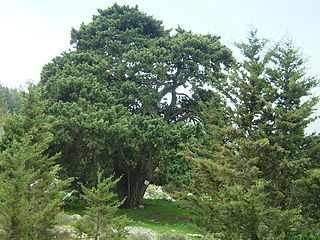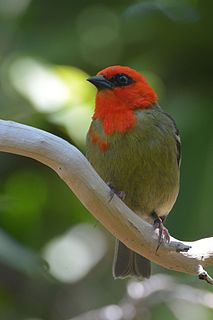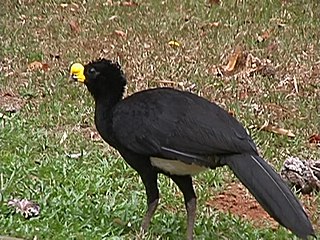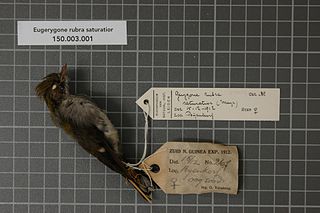
Alder is the common name of a genus of flowering plants (Alnus) belonging to the birch family Betulaceae. The genus comprises about 35 species of monoecious trees and shrubs, a few reaching a large size, distributed throughout the north temperate zone with a few species extending into Central America, as well as the northern and southern Andes.

Kingfishers or Alcedinidae are a family of small to medium-sized, brightly colored birds in the order Coraciiformes. They have a cosmopolitan distribution, with most species found in the tropical regions of Africa, Asia, and Oceania. The family contains 114 species and is divided into three subfamilies and 19 genera. All kingfishers have large heads, long, sharp, pointed bills, short legs, and stubby tails. Most species have bright plumage with only small differences between the sexes. Most species are tropical in distribution, and a slight majority are found only in forests. They consume a wide range of prey usually caught by swooping down from a perch. While kingfishers are usually thought to live near rivers and eat fish, many species live away from water and eat small invertebrates. Like other members of their order, they nest in cavities, usually tunnels dug into the natural or artificial banks in the ground. Some kingfishers nest in arboreal termite nests. A few species, principally insular forms, are threatened with extinction. In Britain, the word "kingfisher" normally refers to the common kingfisher.

The cuckoos are a family of birds, Cuculidae, the sole taxon in the order Cuculiformes. The cuckoo family includes the common or European cuckoo, roadrunners, koels, malkohas, couas, coucals and anis. The coucals and anis are sometimes separated as distinct families, the Centropodidae and Crotophagidae respectively. The cuckoo order Cuculiformes is one of three that make up the Otidimorphae, the other two being the turacos and the bustards.

Woodpeckers are part of the family Picidae, a group of near-passerine birds that also consist of piculets, wrynecks, and sapsuckers. Members of this family are found worldwide, except for Australia, New Guinea, New Zealand, Madagascar, and the extreme polar regions. Most species live in forests or woodland habitats, although a few species are known that live in treeless areas, such as rocky hillsides and deserts, and the Gila woodpecker specialises in exploiting cacti.

The black-and-white warbler is a species of New World warbler, and the only member of its genus, Mniotilta.

Cupressus is one of several genera within the family Cupressaceae that have the common name cypress; for the others, see cypress. It is considered a polyphyletic group. Based on genetic and morphological analysis, the genus Cupressus is found in the subfamily Cupressoideae. The common name comes from Old French cipres and that from Latin cyparissus, which is the latinisation of the Greek κυπάρισσος (kypárissos).

Myrmica rubra, also known as the European fire ant or common red ant, is a species of ant of the genus Myrmica, found all over Europe and is now invasive in some parts of North America and Asia. It is mainly red in colour, with slightly darker pigmentation on the head. These ants live under stones and fallen trees, and in soil. They are aggressive, often attacking rather than running away, and are equipped with a sting, though they lack the ability to spray formic acid like the genus Formica.

Sarcoscypha is a genus of ascomycete fungus and type genus of the family Sarcoscyphaceae. Species of Sarcoscypha are present in Europe, North America and tropical Asia. They are characterised by a cup-shaped apothecium which is often brightly coloured. Some members of the family such as S. coccinea and the - according to new knowledge - more common S. austriaca in western Europe and United States have bright scarlet apothecia which have given them familiar names such as the scarlet cup fungus and scarlet elf cap.

The glass frogs are frogs of the amphibian family Centrolenidae. While the general background coloration of most glass frogs is primarily lime green, the abdominal skin of some members of this family is transparent. The internal viscera, including the heart, liver, and gastrointestinal tract, are visible through the skin, hence the common name is given as glass frog. Glass frogs are arboreal, meaning they mainly live in trees, and only come out for mating season.

The Mauritius fody is a rare species of bird in the weaver family. It is endemic to the island of Mauritius. It is classified by BirdLife International as being endangered. It is also on the United States' Endangered Species List with an endangered status.

Adelophryne is a genus of frogs in the family Eleutherodactylidae. They are native to northern South America east of the Andes, known roughly from the area corresponding to the Guiana Shield, as well as to the coastal area of Bahia, Brazil. Whether the genus is truly distinct from Phyzelaphryne remains uncertain. Common name shield frogs has been coined for this genus.

Actaea pachypoda is a species of flowering plant in the genus Actaea, of the family Ranunculaceae.

The great curassow is a large, pheasant-like bird from the Neotropical rainforests, its range extending from eastern Mexico, through Central America to western Colombia and northwestern Ecuador. Male birds are black with curly crests and yellow beaks; females come in three colour morphs, barred, rufous and black. These birds form small groups, foraging mainly on the ground for fruits and arthropods, and the occasional small vertebrate, but they roost and nest in trees. This species is monogamous, the male usually building the rather small nest of leaves in which two eggs are laid. This species is threatened by loss of habitat and hunting, and the International Union for Conservation of Nature has rated its conservation status as "vulnerable".

The red warbler is a small passerine bird of the New World warbler family Parulidae endemic to the highlands of Mexico, north of the Isthmus of Tehuantepec. It is closely related to, and forms a superspecies with, the pink-headed warbler of southern Mexico and Guatemala. There are three subspecies, found in disjunct populations, which differ primarily in the color of their ear patch and in the brightness and tone of their body plumage. The adult is bright red, with a white or gray ear patch, depending on the subspecies; young birds are pinkish-brown, with a whitish ear patch and two pale wingbars.

The Fiji crested iguana or Fijian crested iguana is a critically endangered species of iguana native to some of the northwestern islands of the Fijiian archipelago, where it is found in dry forest.

The garnet robin is a species of bird in the family Petroicidae. It is monotypic within the genus Eugerygone. It is found in New Guinea, where its natural habitat is subtropical or tropical moist montane forests.

Aseroe rubra, commonly known as the anemone stinkhorn, sea anemone fungus and starfish fungus, is a common and widespread basidiomycete fungus recognizable for its foul odour of carrion and its sea anemone shape when mature. Found in gardens on mulch and in grassy areas, it resembles a red star-shaped structure covered in brownish slime on a white stalk. It attracts flies, which spread its spores.

Chorioactis is a genus of fungus that contains the single species Chorioactis geaster. The mushroom is commonly known as the devil's cigar or the Texas star in the United States, while in Japan it is called kirinomitake( キリノミタケ). This extremely rare mushroom is notable for its unusual appearance and disjunct distribution: it is found only in select locales in Texas and Japan. The fruit body, which grows on the stumps or dead roots of cedar elms or dead oaks, somewhat resembles a dark brown or black cigar before it splits open radially into a starlike arrangement of four to seven leathery rays. The interior surface of the fruit body bears the spore-bearing tissue known as the hymenium, and is colored white to brown, depending on its age. The fruit body opening can be accompanied by a distinct hissing sound and the release of a smoky cloud of spores.

Sarcoscypha dudleyi, commonly known as the crimson cup or the scarlet cup, is a species of fungus in the Sarcoscyphaceae family of the Pezizales order. In addition to its main distribution in the central to eastern United States, the fungus has also been recorded once in Bulgaria. It has been frequently confused with Sarcoscypha coccinea, but can be distinguished from this and other related species in Sarcoscypha by differences in microscopic characteristics, such as the presence and number of oil droplets in the spores. The species Molliardiomyces dudleyi is an imperfect form of the fungus that lacks a sexually reproductive stage in its life cycle.




















